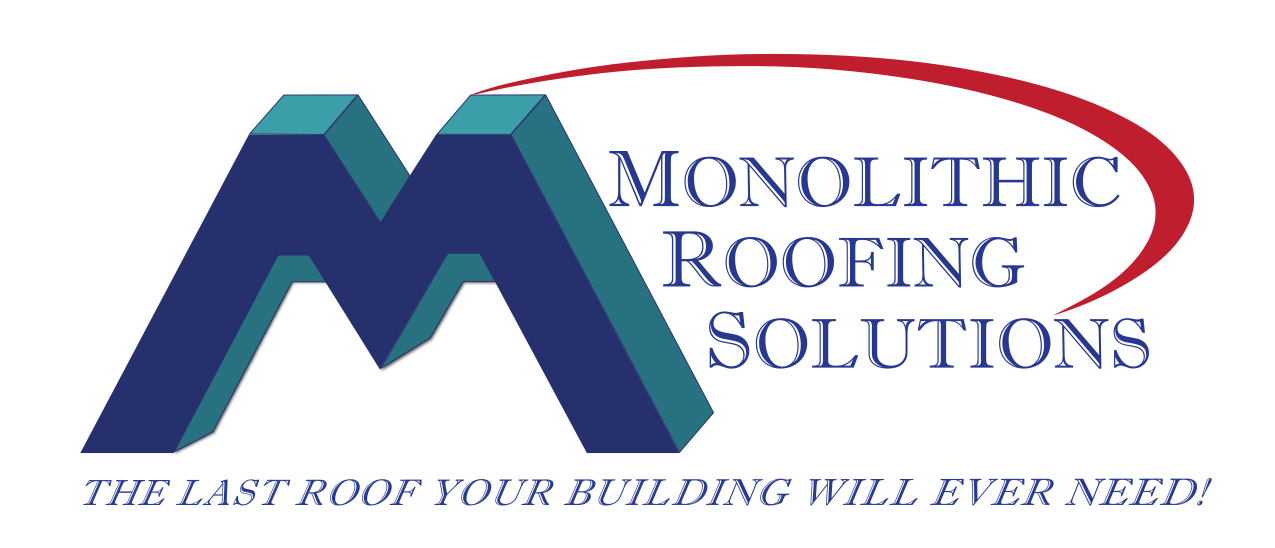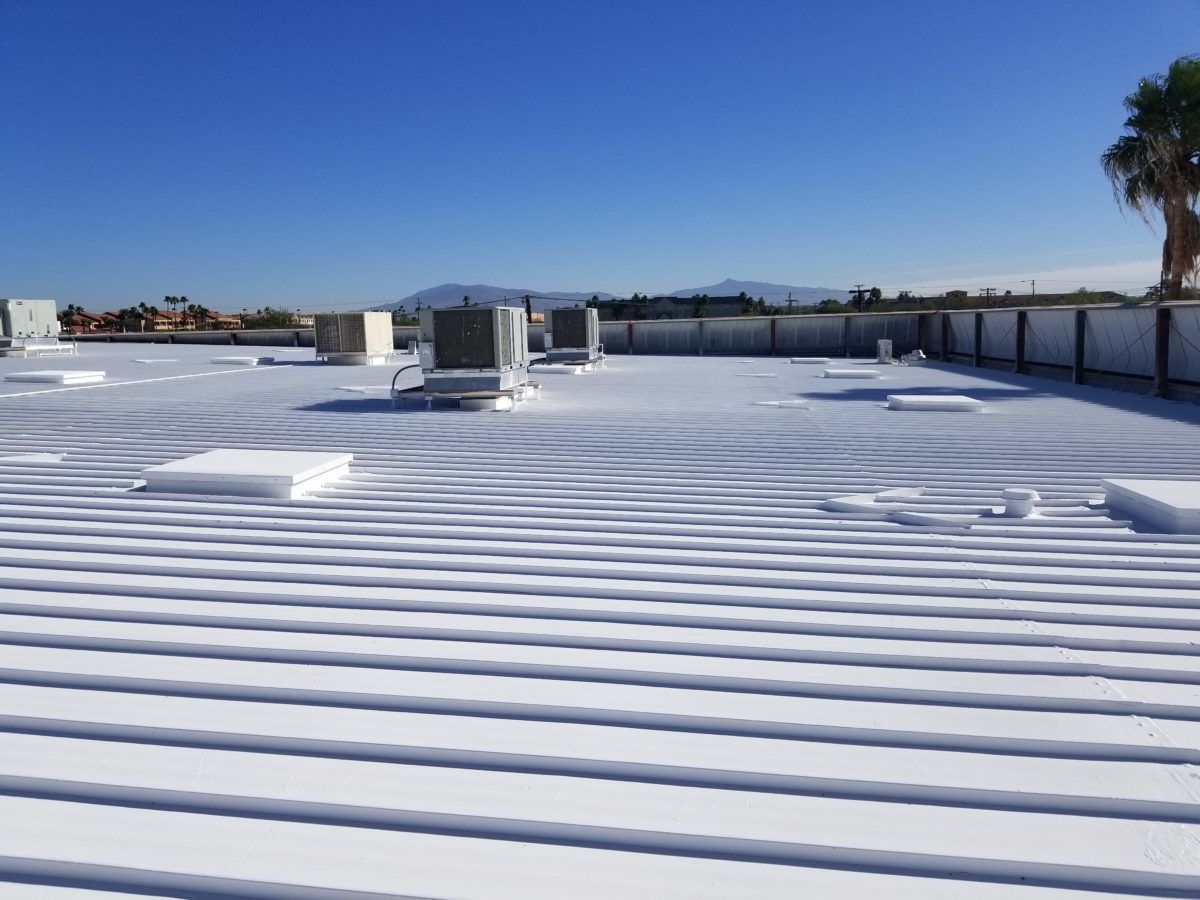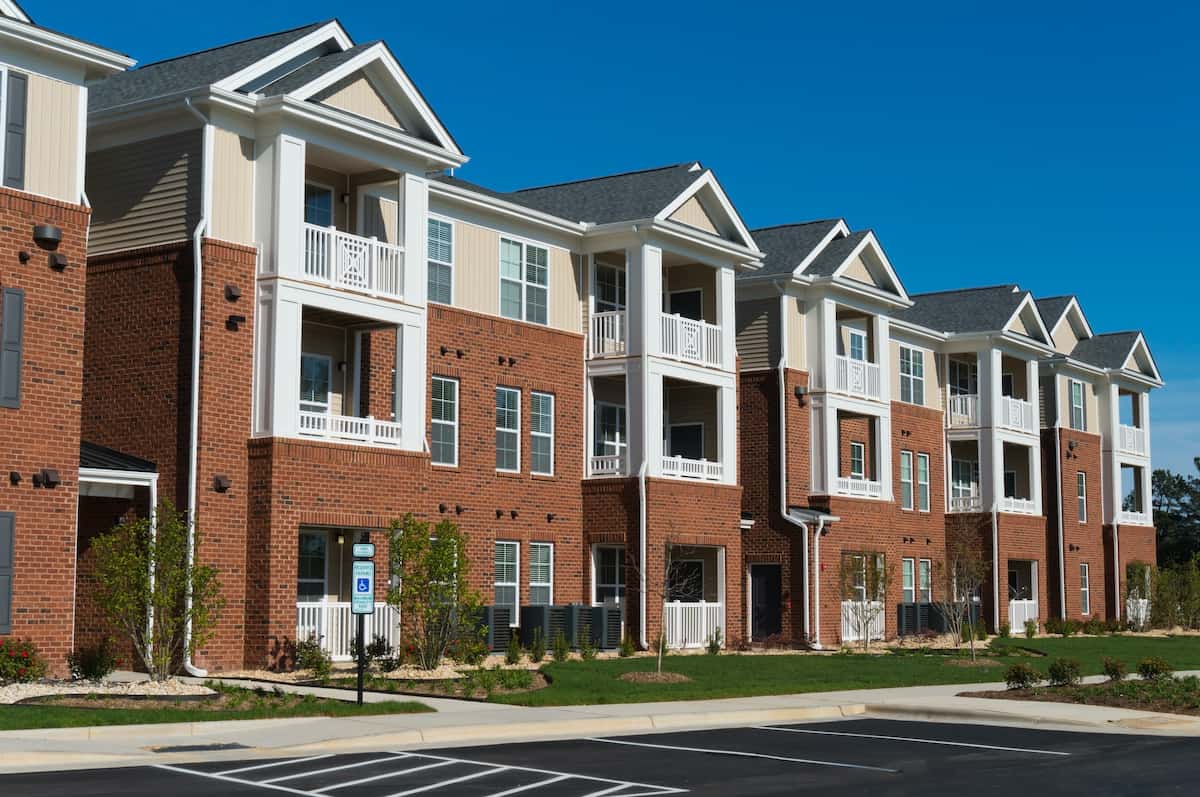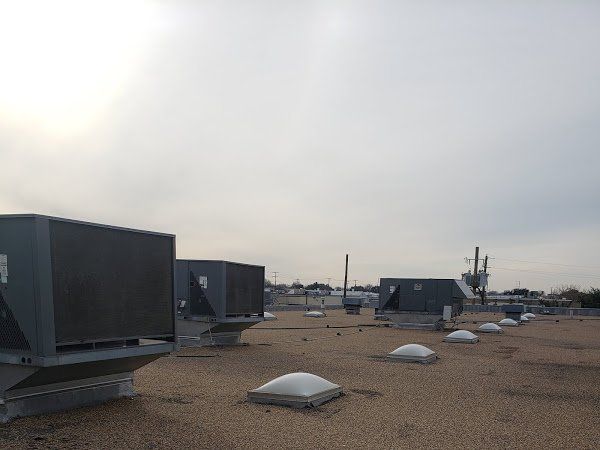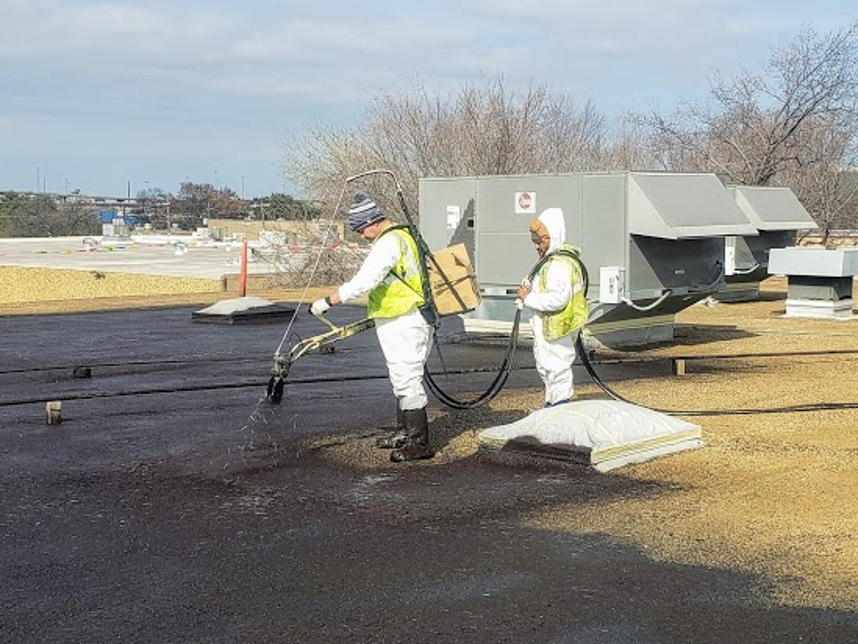Blog & Updates
Blog & Project Updates
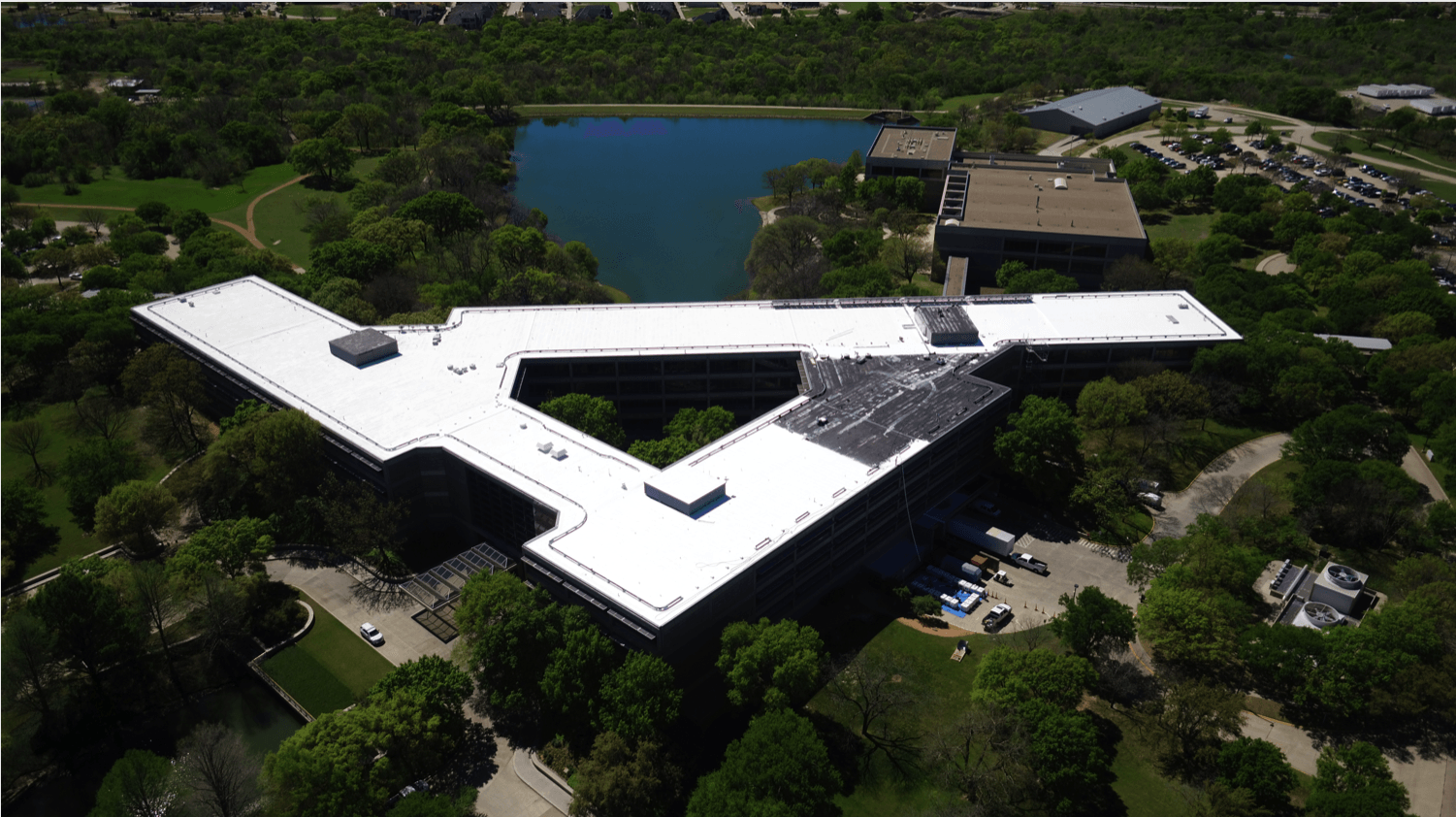
09 Feb, 2021
Have you ever taken the time to put pen to paper and objectively looked at the comparative costs of continuously tearing off and replacing your single ply roof system as compared to a far superior alternative - the seamless FARR ( fluid applied reinforced roof ) hybrid system, that never has to be torn off and replaced? Let’s take a look to see a comparison of the costs and benefits of both membrane systems ---- Long term roof replacement cost comparison of the FARR Hybrid vs Any Single Ply, ie TPO, PVC, EPDM Membrane Assumptions: • Building roof size at 50,000 square feet • Assume a ten year warranty on both systems (15 and 20 year available on both). • The new roof will be the second roof – meaning that for single ply systems, it will have to be torn off before being replaced on future re-roofing. • The FARR Hybrid roof system DOES NOT ever have to be torn off.** • For comparison, assume both roofs initial install cost identical at $3.50 per square foot.
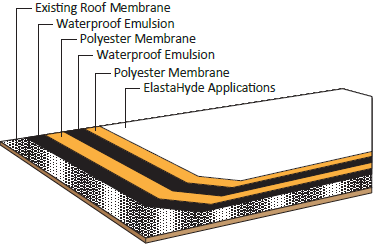
09 Feb, 2021
Coatings are flooding the roofing industry these days. It is rare to find a manufacturer or contractor that is not promoting a “roof coating” or “liquid membrane”. There IS a difference between a coating and a membrane, and it can be hard to draw the line at times. It can be helpful to consider the human anatomy. Skin is a membrane. It’s tough, flexible, and virtually impermeable and it protects the underlying tissues and organs from the outside. However, skin can be damaged if its exposed to the sum too long. Sunscreen is a coating. Its purpose is to protect skin – the membrane – from damage. It is permeable, so it’s still possible to sweat, and its applied relatively thin. It does not last very long, so it needs to be re-applied. Liquid roofing products are not all that dissimilar. There are those that work great as a coating (sunscreen): they are applied in thin layers of 20-30 mils (one mil equals one-thousandth of an inch), defend against UV degradation, are permeable, cool things down (thanks to their reflectiveness), but need t be re-coated and touched up often. They do not perform like a long-lasting membrane, but they are great at protecting membranes. Then there are other liquid products that work great as a membrane: they are thick (50-130 mils), durable, flexible, strong, and impermeable. They serve as a primary barrier separating the structure from the elements. Some are reinforced, some are multi-layered, but the intended purpose is the same. They have no seams, adhere fully, and self-terminate. These liquid-applied, seamless membranes should act more like skin than sunscreen. Installing a seamless membrane directly over an old roof helps maximize the original investment. However, it’s important to note that restorations or recovers are not recommended on roofs that are past a certain point of deterioration or have saturated insulation. Liquid roofing membrane systems are best used for repairs, and/or the restoration of existing roof membranes to avoid costly, disruptive, and wasteful roof tear-offs. While they can be used in a full replacement or new construction, the focus of this article will be on their restorative capabilities. Too often, liquid products are given the same negative stereotype. In Canada, extensive roof coating failures in the 1990’s made building owners leery of anything sold in a bucket or drum. Liquid roof technologies have improved drastically sine then, but each serves a very different purpose. Some liquids are better used as a coating and others as a membrane. Here’s an overview of the applications of some of the most common liquid roof products : Acrylic Acrylic, by itself, is best used as a “sunscreen” for UV protection of membranes to extend their life. It’s great for reflectivity to reduce surface temperature and energy costs (depending on insulation in the existing roof). Other pros include that they’re low-cost, come in a variety of color options, serve as a good sacrificial wear layer and are easy to recoat. The cons. Cheaper varieties of acrylic liquid roofing products are just that. Unless they’re reinforced (like with a high quality polyester) they don’t withstand ponding water well, are inflexible, have low strength and in some cases have been inappropriately promoted as a membrane. Silicone. Silicone is best used as a topcoat over a membrane to prevent premature degradation, extend life, and add reflectivity . Other pros include that it’s reflective, withstands ponding water, resists animal fats, has good tensile strength and experiences minimal degradation. However, its exceedingly difficult to repair or recoat, as nothing but silicone will adhere to silicone. Other cons include that it is not water-based, picks up dirt (turns yellow/brown quickly), has poor tear resistance and is slippery when wet. Polyurethane Foam Roofing Products Polyurethane foam is best used as insulation material, not as a waterproofing membrane. Its topcoat is typically acrylic or silicone and requires constant maintenance to protect the foam from UV exposure. The pros of polyurethane foam are that it provides excellent insulation (it has a high R-value), can be applied to any thickness and is watertight. The cons of polyurethane foam are that it’s not UV stable, requires a top coat to protect it from becoming open-cell, is easily punctured and damaged by foot traffic, birds, and insects, is difficult to install, has no elongation and low strength. Urethane Roofing Products Urethane is best used as a membrane for parking decks, flooring, plaza decks, and other industrial applications. It’s suitable for use on certain types of existing roofs but is difficult to repair or recoat. The pros of urethane are that it’s strong and durable, impermeable and has high tensile strength. The cons of urethane are that its installation is sensitive, causes toxic fumes, is flammable in liquid form, can be expensive and has low elongation. Liquid Rubber Roofing Products Liquid rubber is best used as a roof restoration membrane with a reflective topcoat. The pros of liquid rubber are that it has high elongation, good tensile strength, can be applied in any thickness in one coat, is impermeable, has excellent adhesion and can be installed to membrane thickness. The cons of liquid rubber are that it only comes in one color (black), typically requires top coat, is more expensive and cannot be installed in freezing temperatures. Hybrids Hybrid systems are membranes that include many of the best qualities of coatings but in addition, because they contain multiple layers of waterproofing and are reinforced with high strength polyester, are a superior long lasting membrane. Unlike most other membrane systems that have to be torn off and replaced at the expiration of their useful life - hybrid systems by design, if properly maintained, can have their warranties extended indefinitely by simply replenishing the protective top layer of acrylic periodically. In addition, they can usually be installed over any type of existing roof system (caution: substrate cannot have substantial damage including water saturation of insulation) and are fully code compliant being installed on facilities with two roofs already in place - without the need for a tear-off. With many liquid technologies available to protect roof assets, it is important to choose the right product for the application. A new membrane many be needed, and a thin coating would only cause further problems. Or a new membrane may not be needed, only a coating to increase the roofs life. Never hesitate to ask contractors, consultants, or suppliers for physical material samples, independent lab tests reports, data sheets, contractor certifications, case studies, and references. Proper due diligence is vital when investing further in existing roof assets. Monolithic Roofing Solutions MRS) is a certified dealer/installer of Western Colloid's hybrid seamless single-ply built up FARR (fluid applied reinforced roof) systems . To see if your roof would be a candidate for this exclusive roofing system, call us for a complimentary inspection and analysis. “The Last Roof Your Building Will Ever Need!” Monolithic Roofing Solutions 525 Industrial Blvd. Suite A, Grapevine Texas (469) 628-4441 www.monolithicroofingsolutions.com
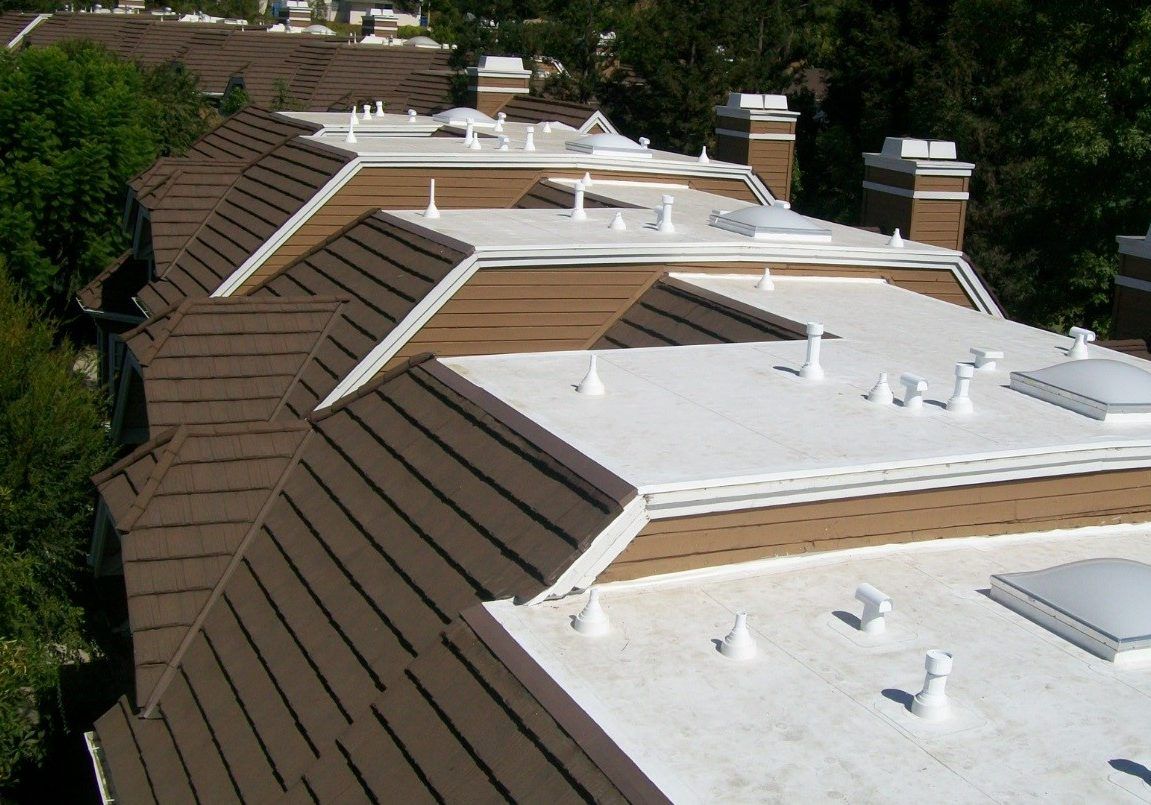
03 Feb, 2021
Is there a difference? Yes, a HUGE one. Cold, Fluid applied Roofing and Waterproofing Membranes BACKGROUND Within the context of the roofing industry, what is the first thing that comes to mind when the word “coating” is mentioned? What about the word “membrane?” Fluid applied roofing and waterproofing membranes should not be confused with coatings . When speaking of coatings, we tend to think of materials that sometimes (and I stress sometimes) allow for the furthering of a roof's service life, or materials used as a reflective and sometimes UV resistant coating for metal roofs, various single ply membranes and sprayed polyurethane foam. We may also think about deck and traffic coatings that are used as aesthetic wear surfaces for concrete. What we don't tend to think of, are strong, durable, trafficable, UV resistant materials that can withstand ponded water and immersion and serve as long term primary weather barriers just as, if not more effectively than, traditional, singleply, asphalt, and bitumen based systems. The purpose of this article is to inform the reader of the relatively long and successful history and effectiveness of fluid applied roofing and waterproofing membranes and to distinguish them from the coatings that are not generally thought of as long-term solutions in the low slope commercial roofing market. We will do so by covering the following topics: membrane manufacturing, advantages of fluid applied membranes, market acceptance, contractors, training and quality assurance and quality control, common fluid applied membrane types, design considerations, system installation, and detailing. MEMBRANE MANUFACTURING Here's a very general statement: “All roofing membranes are liquid at one stage.” Do you agree or disagree? If you said to yourself that roofing membranes do not only consist of materials that were liquid at some point, you are correct. For example, polyester and fiberglass reinforcements are never liquid. However, the material that serves as the basis for every roofing membrane – without exception – is always liquid at some point in its existence. Trinidad Lake and the Brea Tar Pits are the two largest sources of natural bitumen in the western hemisphere. Natural bitumen is mined or refined from crude oil and transported to a manufacturing facility, where it is modified with various rubbers and plasticizers. Reinforcement is then added to provide additional tensile strength, which results in a roofing membrane that is transported to a project site for installation and “seaming.” The same holds true for PVC, EPDM, TPO, and other materials that use polymers as the basis for sheet goods. There are no single ply membrane mines where sheets are pulled from the ground. They are produced in a controlled environment because the liquid polymers are toxic, do not keep well in a can, cannot be cured at a wide range of temperatures, and a whole host of other factors. So, if you had a liquid polymer that was able to withstand these conditions, why not deliver it to the site, combine it with reinforcement, and create a seamless, truly fully adhered membrane system, in situ? ADVANTAGES OF FLUID-APPLIED MEMBRANES While generally perceived to be “new” technology, cold, fluid applied roofing and waterproofing membranes have been used extensively within the U.S. for the past 45+ years. Many fluid applied systems are; UV resistant, applied in a variety of climates, resistant to heavy traffic, chemicals, and petroleum products, self-flashing and applied without the aid of open flame or heat. Many have also been tested to the most rigorous standards by the most recognized testing companies in the U.S. and abroad. Use of these materials in the U.S. has been predominantly focused along the eastern seaboard and in the Pacific Northwest, where the technologies were originally introduced. They have also been applied throughout the world, from the Middle and Far East to the northern reaches of Scandinavia. This application history has allowed many of these technologies to prove their ability to deal with the harshest of UV exposures, freeze/thaw, and severe wet and dry conditions. Their exceptional resistance to chemicals and ability to perform in complete immersion has also allowed these systems to prove their worth in a whole host of application conditions, from roofs to primary and secondary containments. Many are capable of withstanding a significant amount of traffic, both pedestrian and vehicular, which also allows for their use on balconies, parking decks, and in other high traffic situations. Because these materials allow for the in situ manufacturing of membranes, traditional flashing details (i.e., pitch pockets, compression rings, etc.) and seams (which are a common source of roofing system failures), are eliminated. Membranes are flashed directly to penetrations and drain bowls and do not require the use of preassembled base flashings. They are equally capable of being terminated within a reglet or at a free edge, and do not require termination bars or other mechanical attachment to keep them flush to a substrate. As we have seen over the past few years, insurance companies are objecting more and more to the use of torches and other heat related equipment in the roofing industry. In some European countries, the use of torches and other open flame equipment has been completely banned. In today's highly litigious roofing market, perhaps the most important aspect of these technologies is their ability to be applied without the use of heat. Kettles, melters, hot air and gas guns, and torches are being replaced with brushes, rollers, and mixers. This should come as a comfort to the insurance companies, building owners, and contractors alike as each stand to benefit from the eventual acceptance of these technologies in the market-place. Market Acceptance, Contractors, Training, and QA/QC It is the roofing market's general lack of acceptance and desire to understand these systems that result in the technologies' most significant drawbacks. As mentioned earlier, a large percentage of low slope roofing systems are factory cured sheets. The fact that they are cured in a controlled environment allows for a high level of quality assurance and control (QA/QC) to ensure the physical properties of the membrane are kept within a predetermined specification (i.e., thickness). Fluid applied systems are no different in that they require a high level of QA/QC. It is where this QA/QC is carried out and by whom, which represents the biggest difference among them and singleply and modified bitumen systems. While the base polymers for fluid applied systems undergo the same, if not more, QA/QC than the various polymers and modified bitumen’s used for factory cured sheets, fluid applied technologies rely on field QA/QC to ensure the finished physical properties of the membrane. While factory cured sheets also must rely on field QA/QC to ensure proper performance, it is the focus of that QA/QC that is different. Since the physical properties of sheet goods have already been checked for specification conformance prior to delivery to the project site, installation QA/QC is focused on ensuring parameters such as adequate laps, seam integrity, fastening patterns, pitch pocket construction, etc. Since fluid applied systems are seamless, self-flashing, and require no mechanical attachment, field QA/QC for these systems is more centered on finished membrane thickness and consistency of reinforcement. In either case, it is imperative that the installation be performed by a qualified contractor, under the manufacturer's supervision. Because of the reliance on contractors to ensure the physical properties of fluid applied membranes meet specifications, training programs are tailored to cover standard installation requirements (i.e., termination details), in addition to stressing the importance of finished membrane thickness and reinforcement consistency. The need to understand these properties is not something that roofing contractors are used to, and something they do not want to understand. I go back to my earlier point about the roofing market's general lack of acceptance of fluid systems representing the largest potential for pitfalls. The early adopters of these systems were not roofing focused, but restoration and waterproofing focused. This is true for both the contracting and specification communities. Restoration and waterproofing focused contractors typically have composite work crews; meaning they have skilled masons, painters, roofers, and sheet metal workers that bring a broad base of experience to a project. These contractors understand how to use a variety of different sealants, scarify, or rebuild a concrete deck, and rebuild and repoint a cavity wall. They also tend to be versed in the application of wall and deck coatings, which require them to understand a variety of reinforcing materials and the importance of dry and wet film thickness; whereas the preponderance of roofing contractors rely on subcontractors to perform this work. This is not to say that roofing contractors do not or cannot install these systems (some of the best installers are roofers), but it has been the author's experience that those who do are either looking to differentiate themselves from their competition or are entrepreneurial enough to see the future. Until recently, the same held true for the specification community. The trend among specifiers was for those more specialized in forensic engineering and waterproofing to latch onto these technologies, while those more focused on roofing as a subset of the “building envelope” lagged behind. As evidenced by the recent expansion of the former Roof Consultants Institute (RCI) into the “building envelope,” I am pleased to say that this trend is in the process of changing. More and more, the fluid applied systems outlined in the next section are being specified for low slope roofing and waterproofing applications by roof consultants, engineers, and architects alike. DESIGN CONSIDERATIONS Like any other project, it must first be determined whether a restoration/recover is possible, or whether a complete reroof is warranted. Just because the membrane is being installed as a fluid does not mean that good, common, and customary roofing practices get thrown by the wayside. Nondestructive testing (i.e., infrared, nuclear density, capacitance, etc.) in combination with a series of core samples should always be performed prior to deciding on recover suitability. Likewise, evaluation of the integrity of existing mechanically attached roofing should also be conducted. Besides the evaluation of the roofing assembly to be recovered, the existing condition of the surface to which the membrane will be applied must also be evaluated, and a determination made as to whether the substrate is acceptable to treat. Substrates that may be suitable for recover include but are not limited to: singleply and elastomeric membranes, modified bitumen, asphalt, and metal. It is important to check with the material manufacturer for priming schedules and requirements for evaluating substrate suitability. Recovers can be performed direct to existing, exposed surfaces, or can be reclaimed with the use of a carrier membrane or base sheet. In some cases, code compliance requirements will dictate that an otherwise suitable recover situation must be replaced in its entirety. SYSTEM INSTALLATION Restoration/Recovery If a restoration is determined to be suitable, the surface to which the fluid applied membrane will be applied must be free from dirt, debris, laitance, and any poorly adhered materials. Surface preparation requirements typically involve a medium power wash using an antifungal, quaternary ammonia compound. Some applications, particularly well weathered, singleply membranes, may require a solvent wipe. For heavily textured surfaces, a base sheet can be fully adhered to provide a more suitable surface for the fluid applied membrane. Once prepared, some but not all surfaces may require a primer. As mentioned earlier, it is important to check with the manufacturer for priming schedules and requirements for evaluating substrate suitability. Following the application and curing of any required primers, a base coat of material will be applied by brush, roller, or airless spray. The material will be applied at a recommended wet film thickness (WFT) as outlined by the manufacturer. The specified mil thickness represents enough material to fully embed (“wet out”) the membrane reinforcement, which will be laid into the base coat of material. As the base coat of polymer and reinforcement represent the primary waterproofing barrier, it is imperative that no pinholes exist. Once cured, the base coat of the system is top coated to achieve a predetermined, uniform, dry film thickness (dft), which also determines the length of the warranty period. Finished membrane mil thicknesses can range from as little as 0.060" to more than 0.100". Silica quartz may be broadcast into additional topcoats to achieve antiskid qualities. Antiskid surfaces can be locally applied to common areas and walkways, or to the entire system. SYSTEM DETAILING It is very straightforward. Low flashing height – no problem; irregular penetrations – no problem; expansion joints, cracked substrates, differential movement – you guessed it – no problem. The ability of these systems to efficiently deal with the aforementioned problems, and their ability to bond to a multitude of substrates are what have driven a few of the major U.S. roofing manufacturers to adopt these technologies for difficult flashing details. Because they are applied in situ, the membranes can be transitioned directly to parapet walls, vent pipes and stacks, drain bowls, roof hatches, and mechanical equipment. Anything is possible with fluid applied roofing and waterproofing membranes. And, if designed using good engineering practice, in conjunction with the manufacturer, and installed by a qualified contractor, the future performance of the system is assured. [Author, This article has been slightly modified from an article originally written by Franklyn Dippolito]. Monolithic Roofing Solutions is a commercial roofing contractor in Grapevine Texas . They are a certified dealer/installer for Western Colloid 's hybrid seamless, single-ply build-up FARR (fluid applied reinforced roof) restoration roofing system. Call today to arrange for an inspection and evaluation as to whether your roof is a candidate for this system – Literally, “The Last Roof Your Building Will Ever Need!” Monolithic Roofing Solutions 525 Industrial Blvd. Suite A, Grapevine Texas (469) 628-4441 www.monolithicroofingsolutions.com

11 Jan, 2021
This commercial roofing system is best described as a hybrid of single-ply and built-up roofing systems. FARR roofing systems take the best from both, to provide a superior, long lasting, sustainable roofing system that building owners and property managers can specify and install with the confidence of nearly 50 years of successful system performance.
525 Industrial Blvd.
Suite A
Suite A
Grapevine, TX 76051
